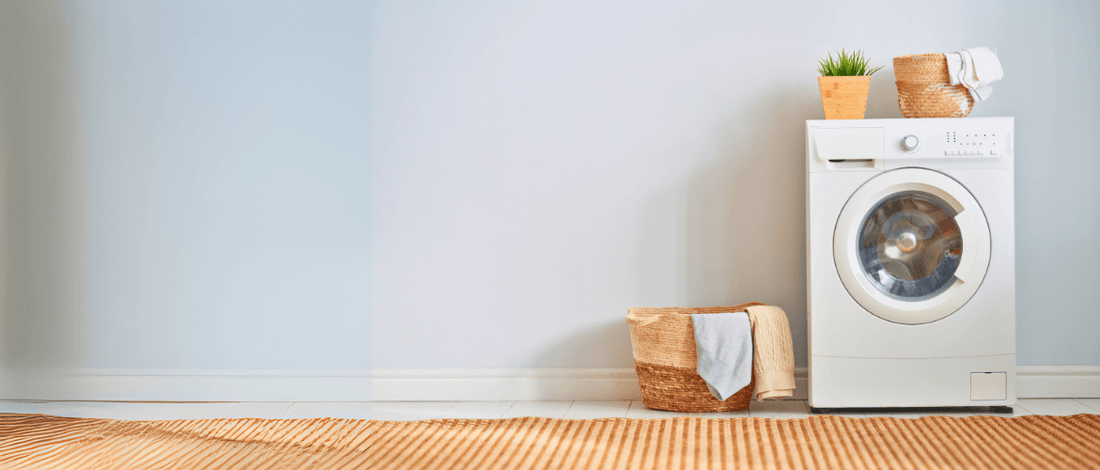
No more smelly laundry The best tips for cleaning washing machines
The regular cleaning of your washing machine is crucial to maintaining its efficiency and service life. Over time, dirt, detergent residue and limescale deposits can build up, which not only affect performance but can also cause unpleasant odors. In this comprehensive guide, you will learn how to thoroughly clean and maintain your washing machine to achieve optimal washing results.
Why is cleaning the washing machine important?
Although the washing machine is designed to keep our clothes clean, it can itself become dirty over time. Limescale deposits, detergent residues and dirt particles build up in the drum, the hoses and the door seal. These residues can not only impair washing performance, but also cause unpleasant odors.
Another problem is the formation of bacteria and mold, especially in damp and poorly ventilated machines. These microorganisms can spread to clothing and cause health problems such as skin irritation. Especially at low washing temperatures of 30 or 40 degrees, germs are not completely killed, which means that impurities accumulate more quickly.
In addition to hygienic aspects, regular cleaning extends the service life of the washing machine. Limescale deposits in the heating elements lead to higher energy consumption and can cause expensive repairs in the long term. A clean machine not only ensures fresh laundry, but also saves electricity and maintenance costs. It is therefore advisable to clean the washing machine thoroughly at regular intervals.

How often should the washing machine be cleaned?
The frequency of cleaning depends on various factors, including the frequency of use, the water hardness and the detergents used. It is generally recommended:
-
Drum cleaning: At least once a month with a wash cycle at 60 °C or 90 °C to reduce bacteria and mold.
-
Detergent compartment and door seal: Clean every two to four weeks with a damp cloth and mild detergent.
-
Fluff filter: Check and clean approximately every three months to prevent blockages.
-
Hoses and water supply: Check for limescale and deposits every six months.
If you frequently wash at low temperatures or with liquid detergents, you should clean the machine even more often. A good guide is to look out for signs such as unpleasant odors, mould growth or a decrease in washing performance. Regular care not only ensures hygienic laundry, but also a long service life for your washing machine.

Step-by-step instructions for cleaning
To keep your washing machine hygienically clean, various parts should be cleaned regularly. Here is a simple step-by-step guide:
1. cleaning the lint filter
-
Switch off the washing machine and pull out the mains plug.
-
Open the lint filter (usually at the bottom at the front of the machine) and remove it.
-
Rinse thoroughly under running water and remove any deposits.
2. cleaning the detergent compartment
-
Pull out the detergent compartment and clean with warm water and a brush.
-
Pay particular attention to detergent residues and mold growth.
-
Allow the cleaned compartment to dry completely before replacing it.
3. cleaning the door seal
-
Wipe the rubber seal with a damp cloth and a little vinegar or mild detergent.
-
Remove hidden dirt particles or mold with an old toothbrush.
-
Leave the door open to allow the seal to dry.
4. cleaning the drum
-
Start a wash cycle at 60 °C or 90 °C without laundry.
-
Depending on your preference, you can use special washing machine cleaners or household remedies such as baking soda and vinegar.
-
After the wash cycle, leave the door open so that the machine can dry properly.
5. cleaning the hoses and water supply
-
Check the water inlet hose occasionally for limescale deposits.
-
Descale if necessary or replace if there are heavy deposits.
These instructions will keep your washing machine clean, odor-free and powerful. Regular cleaning not only ensures hygienically fresh laundry, but also prevents expensive repairs and extends the service life of your machine.
Use of household cleaning products
Many conventional washing machine cleaners contain aggressive chemicals that are not only harmful to the environment, but also expensive. There are a variety of household remedies that are just as effective and more environmentally friendly. Baking soda, vinegar, citric acid and baking powder are proven helpers for removing limescale deposits, detergent residues and unpleasant odors in the washing machine.
Home remedies have the advantage that they are gentle on the machine and have an antibacterial effect at the same time. They are also inexpensive and available in almost every household. In the following, we will show you how you can use these agents effectively to clean your washing machine.

Baking soda and vinegar
Baking soda and vinegar are an unbeatable combination when it comes to thoroughly cleaning the washing machine. While baking soda neutralizes deposits and odours, vinegar dissolves limescale and kills bacteria.
Application:
-
Add about 50 g of baking soda to the detergent compartment.
-
Pour 500 ml of white vinegar directly into the drum.
-
Start a hot wash program (60-90 °C) without laundry.
-
After the wash cycle, leave the door open so that the machine can dry.
This method should not be used too often, as vinegar can attack the rubber seals in the long term. However, once a month is unproblematic and ensures a hygienically clean machine.
Citric acid
Citric acid is another excellent household remedy for cleaning the washing machine, especially for removing limescale deposits. It is gentler than vinegar and does not attack the rubber seals.
Application:
-
Add about 5 tablespoons of citric acid to the detergent compartment.
-
Run the machine at 40-60 °C without washing.
-
After the wash cycle, leave the door and the detergent compartment open to allow moisture to escape.
Citric acid not only has a descaling effect, but also leaves behind a pleasant fresh fragrance. This method can be used every 1-2 months.
Baking powder
Baking soda is also an effective household remedy for cleaning the washing machine. It removes grease and detergent residues and neutralizes odours.
Application:
-
Place two sachets of baking soda in the detergent compartment.
-
Start a hot wash program (60-90 °C).
-
After the wash cycle, wipe out the drum with a dry cloth.
Baking soda is particularly suitable if the washing machine smells unpleasant. It is a gentle method that can be used every few weeks.
Tips for preventing soiling
Regular cleaning is important, but it is even better to avoid soiling in the first place. With a few simple measures, you can prevent the build-up of limescale, mold and unpleasant odors in your washing machine.
-
Leave the door and detergent compartment open: After each wash cycle, the door and detergent compartment should be left open to allow the residual moisture to evaporate and prevent mold from forming.
-
Do not use too much detergent: Overdosing detergent leads to deposits in the machine. Follow the manufacturer's dosage recommendations.
-
Occasionally wash hot: Many people mainly wash at low temperatures. An occasional wash cycle at 60 °C or higher helps to remove bacteria and detergent residues.
-
Avoid fabric softener: Fabric softeners can stain the machine and lead to unpleasant odors. Alternatively, vinegar can be used as a natural fabric softener.
-
Do not leave laundry in the machine for too long: Damp laundry left in the drum for a long time promotes mold growth and bad odors. Remove the laundry immediately after washing.
These simple tips will keep your washing machine clean, hygienic and efficient in the long term. Regular care and the targeted use of household products will ensure a long service life and always fresh-smelling laundry.
To use your washing machine for longer and store it more decoratively, you can take a look at our washing machine cabinets take a look at our washing machine cabinets.
